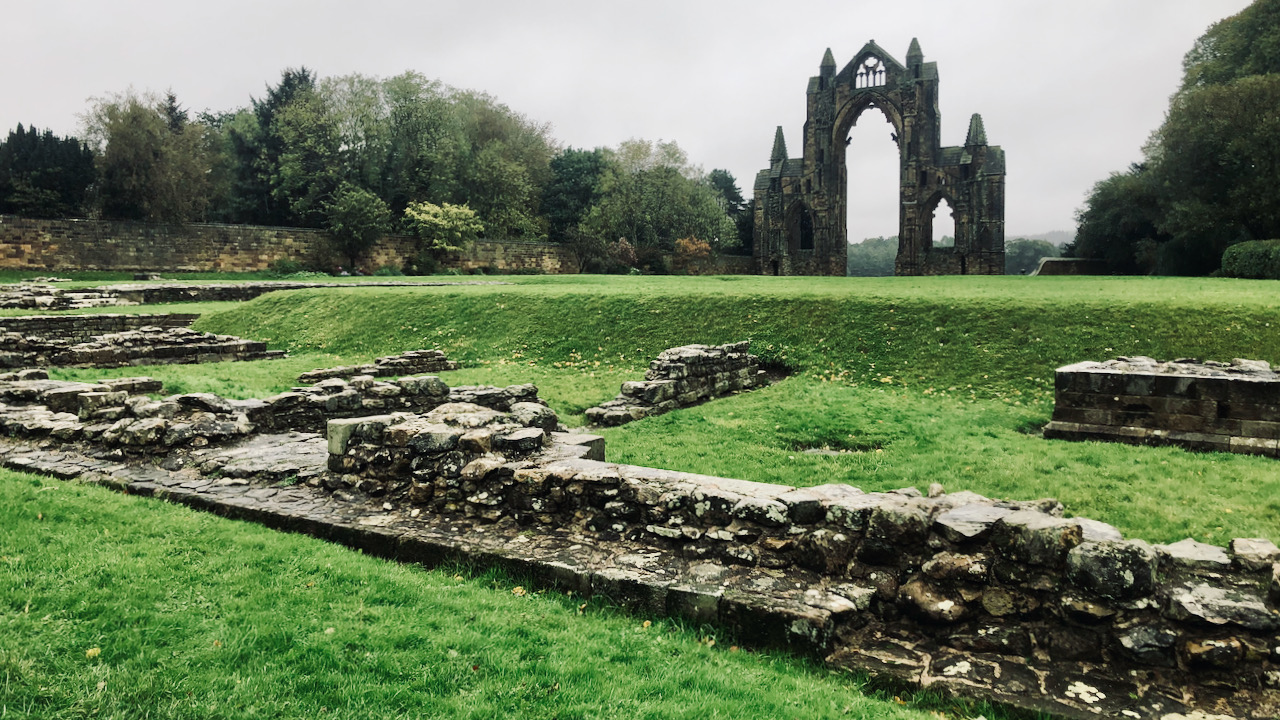On another dreich morning, I avoided the hills. Guisborough Priory, founded in 1119, predates Rievaulx (1132). As someone with a background in construction, I often ponder the time and resources invested in such historical structures.
What stands before us today are the remains of the third stone church. The initial stone church commenced around 1140, likely completed by 1180. Shortly after, it was razed to the ground to make way for a new one. Construction followed the usual east-to-west pattern, wrapping up at the west end circa 12401GPP. 2021. ‘900 Years of History – Gisborough Priory Project’, Gisborough Priory Project – Explore Gisborough Priory & Woodland Gardens <https://gisboroughprioryproject.org.uk/900-years-of-history/> [accessed 21 October 2023].
In 1289, disaster struck during roof repairs when a fire broke out. It ravaged the church, consuming books, chalices, vestments, and statues. The rebuilding effort spanned nearly a century, resulting in the third and final iteration of the church, the one we see today2Ibid..
So, we’re talking about two centuries of almost uninterrupted construction work, demanding a substantial labour force, both skilled and unskilled. Monumental projects like this were sprouting up all over the country. In the two centuries post-Conquest, 480 castles, 20 cathedrals, 140 Augustinian and 40 Cistercian monasteries, 60 Dominican and 57 Franciscan houses emerged. Nearly every parish saw its church revamped. And then there were Royal and Episcopal palaces, and collegiate edifices3Wood, Eric S. “Historical Britain”. Page 181. The Harvill Press. 1997..
At the time of the Conquest, England’s population just exceeded two million, and this labour demand surely strained resources. Estimating the exact manpower for a given project is tricky. But, when they had to rush Beaumaris Castle’s construction on Anglesey in 1295, it swallowed up 400 masons, 2,000 labourers, 30 smiths, plus carpenters, quarrymen, carts, and ships4Ibid..
This building frenzy called for a large, well-organised industry. In Norman times, clerics and military clerks had architectural know-how, but by the late 12th century, lay organisations had taken over. There were two ways to construct a grand church: direct or via contracts. Initially, a monk or canon appointed by the Chapter oversaw the work, with a master mason managing the craftsmen. Gradually, certain craftsmen received lump sum payments for their tasks, leading to the contract system5Ibid..
The master mason initially lived on-site but later became a supervising visitor, overseeing multiple jobs, each with a resident deputy. Masons worked in open huts or lean-tos called ‘lodges.’ Freemasons cut and carved freestone, while rough-masons squared the stone and crafted straight mouldings. Carpenters, smiths, glaziers, clerks, and numerous labourers all had their roles. Tools and equipment were basic, and plans were diagrammatic. Builders knew what was needed, but not precisely how to achieve it. The master mason sourced the stone, sometimes reusing old materials. Half the cost was for materials, with half of that going to transport. The other half went to finishing and erecting. On smaller projects, the workforce was itinerant, moving from one job to the next, with a few masons staying put if the work was lengthy6Ibid..
The actual building process was incredibly laborious. Each stone had to be raised into place on a growing scaffold of wooden supports, using windlasses, hoists, tread wheel cranes, and pulleys7Ibid.. The vaulting, flying buttresses and the great window of Guisborough east wall would have been set on pre-erected timber frames.
- 1GPP. 2021. ‘900 Years of History – Gisborough Priory Project’, Gisborough Priory Project – Explore Gisborough Priory & Woodland Gardens <https://gisboroughprioryproject.org.uk/900-years-of-history/> [accessed 21 October 2023]
- 2Ibid.
- 3Wood, Eric S. “Historical Britain”. Page 181. The Harvill Press. 1997.
- 4Ibid.
- 5Ibid.
- 6Ibid.
- 7Ibid.

Leave a Reply